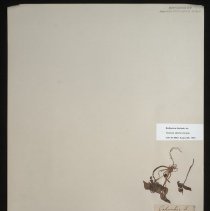Object Record
Images

Metadata
Catalog Number |
PH-LC 63 |
Object Name |
Specimen |
Title |
Claytonia sibirica |
Other Name |
Siberian Montia |
Collector |
Meriwether Lewis & William Clark |
Date |
1806 |
Description |
Pursh (1813: 175) identifies this specimen as Claytonia alsinoides Sims (in Bot. Mag. 32: ad t. 1309. 1810), a synonym of C. sibirica, described from garden material grown from seeds gathered by Menzies during his visits to northwestern America on the Vancouver expedition. Meehan (1898: 20) lists the species as Montia sibirica (L.) Howell (in Erythea 1: 39. 1893). Coues (1898: 295) suggests the specimen was gathered in Multnomah Co., Oregon, "about 10 miles above Quicksand or Sandy River" near "Cape Horn." The site of Lewis and Clark's Cape Horn was across the river in Washington (Moulton, 1991: 14), and the expedition was there on 25 Mar. The label on the sheet written by Pursh only gives "Columbia R. / April. 8th- 1806." Accepting the date, one finds continued confusion as to just where the party camped on 7-8 Apr (Moulton, 1991: 89). The rocky point Coues identified as Cape Horn certainly is Beacon Rock in Skamania Co., Washington. Clark took a group across the Columbia River into Multnomah Co., Oregon. No mention is made of this plant in the journal of either explorer. (The Lewis & Clark Herbarium Digital Imagery Study Set, ANSP, 2002) On deposit at the Academy of Natural Sciences, Philadelphia |
Label |
Starting in 1803, Merriwether Lewis (APS 1803) and William Clark embarked on a 3 year expedition along the Missouri and Columbia rivers to the Pacific Coast. They collected hundreds of plant specimens to carry back to the East Coast. They pressed these plants, attached them to sheets of paper and wrapped them in oilskin to survive the long journey intact. Claytonia sibirica, commonly called Siberian Springbeauty, was collected as a specimen by Lewis and Clark while they were traveling along the Columbia River in late March or early April 1806, towards the end of their expedition. This specimen was collected close to the southern bounds of where this plant can be found. As the name Siberian Springbeauty suggests, the plant is native to coastal Alaska and its neighboring islands and can be found along the western coast of Canada and the United States until southern Oregon. In these regions, the plant was used medicinally as a dermatological and a sore throat treatment and its leaves could also be eaten. |
Credit line |
American Philosophical Society. Gift of Thomas Jefferson, 1805 - 1806. |
Search Terms |
19th century botany Clark herbarium Lewis nineteenth century plant specimen |
Collection |
The Lewis & Clark Herbarium |
